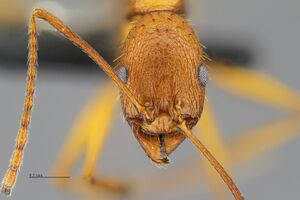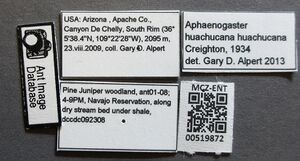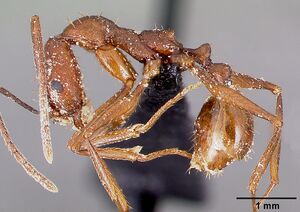Aphaenogaster huachucana
| Aphaenogaster huachucana | |
|---|---|

| |
| Scientific classification | |
| Kingdom: | Animalia |
| Phylum: | Arthropoda |
| Class: | Insecta |
| Order: | Hymenoptera |
| Family: | Formicidae |
| Subfamily: | Myrmicinae |
| Tribe: | Attini |
| Genus: | Aphaenogaster |
| Species: | A. huachucana |
| Binomial name | |
| Aphaenogaster huachucana Creighton, 1934 | |
Identification
Aphaenogaster huachucana is similar in appearance to Aphaenogaster texana, but is larger and found nesting in rocky ledges as opposed to A. texana that can be found under logs and rocks. The antennal scapes pass the occipital margin by one-third the length of the scape. (DeMarco, 2015)
Keys including this Species
Distribution
Latitudinal Distribution Pattern
Latitudinal Range: 37.86° to 31.392878°.
| North Temperate |
North Subtropical |
Tropical | South Subtropical |
South Temperate |
- Source: AntMaps
Distribution based on Regional Taxon Lists
Nearctic Region: United States (type locality).
Neotropical Region: Mexico.
Distribution based on AntMaps
Distribution based on AntWeb specimens
Check data from AntWeb
Countries Occupied
| Number of countries occupied by this species based on AntWiki Regional Taxon Lists. In general, fewer countries occupied indicates a narrower range, while more countries indicates a more widespread species. |

|
Estimated Abundance
| Relative abundance based on number of AntMaps records per species (this species within the purple bar). Fewer records (to the left) indicates a less abundant/encountered species while more records (to the right) indicates more abundant/encountered species. |

|
Biology
This ant forages at dusk and into the night. Nests are often found in steep rocky areas. "It may be added that all the nests of huachucana, including the type nest, were situated on steep slopes. They were placed in shady aspen groves, in the lighter shade of pine groves or in full sun. Some were built in the soil under a covering stone, others in the soil which had accumulated between the stones in a rock slide. In view of the fact that texana is quite fussy about its nest sites, the greater tolerance of huachucana in this respect is surprising" (Creighton, 1952).
Castes
Worker
   
| |
| . | |
Images from AntWeb
   
| |
| Worker. Specimen code casent0000089. Photographer April Nobile, uploaded by California Academy of Sciences. | Owned by CAS, San Francisco, CA, USA. |
Nomenclature
The following information is derived from Barry Bolton's Online Catalogue of the Ants of the World.
- huachucana. Aphaenogaster (Attomyrma) huachucana Creighton, 1934: 189 (w.) U.S.A. (Arizona).
- Creighton, 1952a: 94 (q.m.).
- Status as species: Creighton, 1950a: 144; Smith, M.R. 1951a: 796; Creighton, 1952a: 94; Smith, M.R. 1958c: 117; Smith, M.R. 1967: 352; Hunt & Snelling, 1975: 21; Smith, D.R. 1979: 1361; Allred, 1982: 453; Wheeler, G.C. & Wheeler, J. 1986g: 36 (in key); Bolton, 1995b: 70; Mackay & Mackay, 2002: 75; Mackay & Mackay, 2017: 268 (redescription).
Description
References
- Alatorre-Bracamontes, C.E., Vásquez-Bolaños, M. 2010. Lista comentada de las hormigas (Hymenoptera: Formicidae) del norte de México. Dugesiana 17(1): 9-36.
- Bolton, B. 1995b. A new general catalogue of the ants of the world. Cambridge, Mass.: Harvard University Press, 504 pp. (page 70, catalogue)
- Creighton, W. S. 1934. Descriptions of three new North American ants with certain ecological observations on previously described forms. Psyche (Camb.) 41: 185-200. (page 189, worker described)
- Creighton, W. S. 1952a [1951]. Studies on Arizona ants. 2. New data on the ecology of Aphaenogaster huachucana and a description of the sexual forms. Psyche (Camb.) 58: 89-99.(page 94, queen, male described)
- DeMarco, B.B. 2015. Phylogeny of North American Aphaenogaster species (Hymenoptera: Formicidae) reconstructed with morphological and DNA data. Ph.D. thesis, Michigan State University.
- Varela-Hernández, F., Medel-Zosayas, B., Martínez-Luque, E.O., Jones, R.W., De la Mora, A. 2020. Biodiversity in central Mexico: Assessment of ants in a convergent region. Southwestern Entomologist 454: 673-686.
References based on Global Ant Biodiversity Informatics
- Alatorre-Bracamontes, C.E. and M Vasquez-Bolanos. 2010. Lista comentada de las hormigas (Hymenoptera: Formicidae) del norte de México. Dugesiana 17(1):9-36
- Allred D. M. 1982. Ants of Utah. The Great Basin Naturalist 42: 415-511.
- Allred, D.M. 1982. The ants of Utah. Great Basin Naturalist 42:415-511.
- Bestelmeyer B. T., and J. A. Wiens. 2001. Local and regional-scale responses of ant diversity to a semiarid biome transition. Ecography 24: 381-392.
- Cover S. P., and R. A. Johnson. 20011. Checklist of Arizona Ants. Downloaded on January 7th at http://www.asu.edu/clas/sirgtools/AZants-2011%20updatev2.pdf
- Creighton W. S. 1934. Descriptions of three new North American ants with certain ecological observations on previously described forms. Psyche (Cambridge) 41: 185-200.
- Creighton W. S. 1952. Studies on Arizona ants. 2. New data on the ecology of Aphaenogaster huachucana and a description of the sexual forms. Psyche (Cambridge) 58: 89-99.
- Gans M. J., J. R. Arnold, A. Cohuo, L. Castro, D. Lam, and C. Wiley. 2016. Survey of ant species in Rockwall County, Texas. Southwestern Entomologist 41(2): 373-378.
- Gregg, R.T. 1963. The Ants of Colorado.
- Johnson R. Personnal Database. Accessed on February 5th 2014 at http://www.asu.edu/clas/sirgtools/resources.htm
- Longino, J.T. 2010. Personal Communication. Longino Collection Database
- Vásquez-Bolaños M. 2011. Lista de especies de hormigas (Hymenoptera: Formicidae) para México. Dugesiana 18: 95-133

